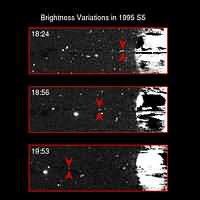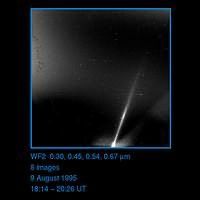1 min read
Brightness Variations in Saturn’s Satellite 1995S5

This sequence of 100 sec exposures taken with HST's Wide Field and Planetary Camera (WFPC2) in planetary mode on 10 August 1995 shows the newly discovered object 1995S5 (red arrows) moving in its orbit around the planet. As it moves further from Saturn, its brightness decreases appreciably. This brightness variation is more consistent with that expected for an elongated, opaque clump of ring material than for a satellite, leading to the suspicion that 1995S5 is in fact a ring arc rather than a previously undiscovered satellite. It is likely that it lies within the narrow, braided F Ring.
In addition to 1995S5, the larger satellites Mimas and Epimetheus are visible in each frame. Mimas is the bright object below the rings, and is seen partly shadowed by the rings in the first frame. In subsequent frames it is in full sunlight. Epimetheus is near the eastern ansa of the rings, moving slowly outward. In the last frame of the sequence tiny Pandora has emerged from Saturn's shadow about 2 arcsec from the planet's limb.
These images were obtained one to two hours before the Earth crossed Saturn's ring plane and an 8922 A methane band filter was used to reduce the scattered light from the planet. An average of several other frames has been subtracted from each image to remove the light from the edge-on rings, and so reveal any faint satellites.
- Object NameObject NameA name or catalog number that astronomers use to identify an astronomical object.Saturn, 1995S5, Mimas, Epimetheus
- Release DateAugust 11, 1995
- Science ReleaseHubble Again Views Saturn’s Rings Edge-On
- Credit
Related Images & Videos

Saturn's Rings Edge-on
Saturn's magnificent ring system is seen tilted edge-on - for the second time this year - in this NASA Hubble Space Telescope picture taken on August 10, 1995, when the planet was 895 million miles (1,440 million kilometers) away. Hubble snapped the image as Earth sped back...

Reappearance of Saturn's Satellite Mimas
On 10 August 1995 HST observed the second passage of the Earth through Saturn's ring plane in the 1995/96 series of triple crossings. This pair of 100 sec exposures was taken with the Wide Field and Planetary Camera (WFPC2) in planetary (high resolution) mode 2.5 hours prior to...

Motion of Saturn's Satellites
This sequence of 100 sec exposures taken with HST's Wide Field and Planetary Camera (WFPC2) in planetary mode on 10 August 1995 shows three of the smaller satellites of Saturn, as well as the newly discovered object 1995S5. Epimetheus is the smaller co-orbital satellite and...

Saturn's E Ring in Ultraviolet Light
Visible from Earth only at times of ring plane crossing, Saturn's tenuous E Ring was discovered during the 1966 crossings and imaged again in 1980. From these observations, its color is known to be distinctively blue. The E Ring was captured in ultraviolet light for the first...
Share
Details
Claire Andreoli
NASA’s Goddard Space Flight Center
Greenbelt, Maryland
claire.andreoli@nasa.gov































